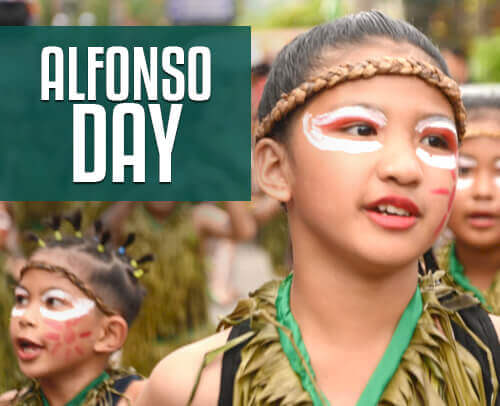HISTORICAL BACKGROUND
The history of Alfonso dates back to the 17th century when it was still a wilderness, a vast land covered with thick forest. About that time, there were few pocket settlements that later composed the sitios Mataywanak, Pajo, Pangasab, and Alas-as. The place was formerly part of Lumampong, a barrio of Indang, Cavite, and continued to be so until the later part of the Spanish regime. Farming was the chief means of livelihood.
In time, the settlements grew to the size of small barrios. Realizing the need for accelerated development, Bonifacio Aveo and Felix Del Mundo, two community leaders, spearheaded a petition requesting the Governor General to make the four barrios into a separate municipality. The petition was granted and the municipal government was placed in Barrios Alas-as, so named after the Alas-as tree. Legend has it own that the early settlers of the place lived near a rivulet along which banks were two big sweet bearing fruit trees called Alas-as.
The original name Alas-as lasted only seventeen years because the Spaniards officially named the town after King Alfonso XII of Spain. Thus, on May 16, 1859, Alfonso became an independent municipality, separate and distinct from Indang.
As in other parts of the country, governmental functions were adopted from Spanish system. The people were forced to give tributes in cash or in kind, mostly agricultural products. In time and with other abuses the settlers began to see that something was wrong with the administration of the Spaniards. They clamored for reforms but the administration turns a deaf ear. Towards the end of the 18th century, the Katipunan was organized to fight the Spaniards. The organization spread to Cavite and the province was one of the eight provinces that included Manila, Batangas, laguna, Bulacan, Pampanga, Tarlac and Nueva Ecija to rise in arms. Alfonso became one of the major centers of the province in the revolutionary activities.
A few days after the Cry of Balintawak on August 26, 1896, General Mariano Trias ordered the liquidation of all Spaniards in the municipality. A bloody battle ensued. Residents were led by prominent men such as General Hipolito Rint, Captain Eriberto Cetro (Kapitan Berto), and Prudencio Rolle (Tandang Dicio).
From the time Alfonso became a municipality, four churches had been erected, three of which were destroyed. The ruins of the third church destroyed by a strong storm in December 1926 can still be seen beside present church, which is the fourth of the series.
The first person to be baptized in Alfonso were Lucia Peñano and Marcelo Peji.
Next to the church is the town’s belfry. The people are proud of this century-old structure because nowhere in the Philippines can be heard as loud and penetrating sound as those produced by giant bells, bought from Spain with money contributed by the people. According to some, the sound of these bells was so loud that it caused the abortion of pregnant women.
Coffee was a major agricultural product. However, it declined in 1925 due to pests and diseases. It was replaced by abaca, which mate a similar fate.





